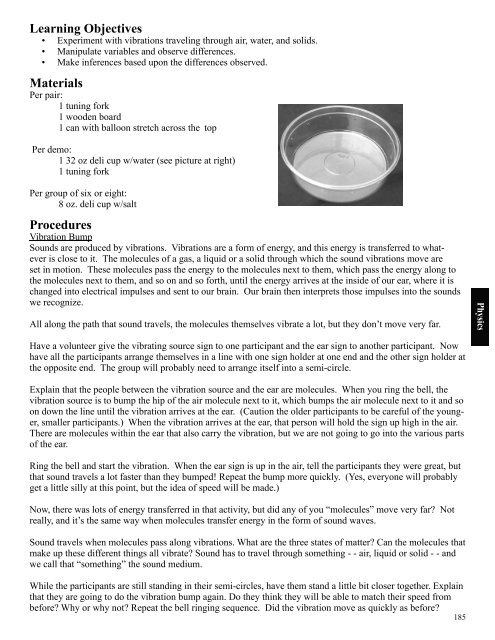ScienceMakers Toolkit Manual - The History Makers
ScienceMakers Toolkit Manual - The History Makers
ScienceMakers Toolkit Manual - The History Makers
You also want an ePaper? Increase the reach of your titles
YUMPU automatically turns print PDFs into web optimized ePapers that Google loves.
Learning Objectives<br />
• Experiment with vibrations traveling through air, water, and solids.<br />
• Manipulate variables and observe differences.<br />
• Make inferences based upon the differences observed.<br />
Materials<br />
Per pair:<br />
1 tuning fork<br />
1 wooden board<br />
1 can with balloon stretch across the top<br />
Per demo:<br />
1 32 oz deli cup w/water (see picture at right)<br />
1 tuning fork<br />
Per group of six or eight:<br />
8 oz. deli cup w/salt<br />
Procedures<br />
Vibration Bump<br />
Sounds are produced by vibrations. Vibrations are a form of energy, and this energy is transferred to whatever<br />
is close to it. <strong>The</strong> molecules of a gas, a liquid or a solid through which the sound vibrations move are<br />
set in motion. <strong>The</strong>se molecules pass the energy to the molecules next to them, which pass the energy along to<br />
the molecules next to them, and so on and so forth, until the energy arrives at the inside of our ear, where it is<br />
changed into electrical impulses and sent to our brain. Our brain then interprets those impulses into the sounds<br />
we recognize.<br />
All along the path that sound travels, the molecules themselves vibrate a lot, but they don’t move very far.<br />
Have a volunteer give the vibrating source sign to one participant and the ear sign to another participant. Now<br />
have all the participants arrange themselves in a line with one sign holder at one end and the other sign holder at<br />
the opposite end. <strong>The</strong> group will probably need to arrange itself into a semi-circle.<br />
Explain that the people between the vibration source and the ear are molecules. When you ring the bell, the<br />
vibration source is to bump the hip of the air molecule next to it, which bumps the air molecule next to it and so<br />
on down the line until the vibration arrives at the ear. (Caution the older participants to be careful of the younger,<br />
smaller participants.) When the vibration arrives at the ear, that person will hold the sign up high in the air.<br />
<strong>The</strong>re are molecules within the ear that also carry the vibration, but we are not going to go into the various parts<br />
of the ear.<br />
Ring the bell and start the vibration. When the ear sign is up in the air, tell the participants they were great, but<br />
that sound travels a lot faster than they bumped! Repeat the bump more quickly. (Yes, everyone will probably<br />
get a little silly at this point, but the idea of speed will be made.)<br />
Now, there was lots of energy transferred in that activity, but did any of you “molecules” move very far? Not<br />
really, and it’s the same way when molecules transfer energy in the form of sound waves.<br />
Sound travels when molecules pass along vibrations. What are the three states of matter? Can the molecules that<br />
make up these different things all vibrate? Sound has to travel through something - - air, liquid or solid - - and<br />
we call that “something” the sound medium.<br />
While the participants are still standing in their semi-circles, have them stand a little bit closer together. Explain<br />
that they are going to do the vibration bump again. Do they think they will be able to match their speed from<br />
before? Why or why not? Repeat the bell ringing sequence. Did the vibration move as quickly as before?<br />
185<br />
Physics










